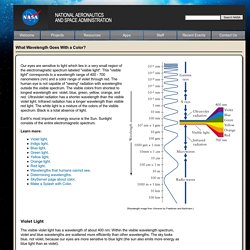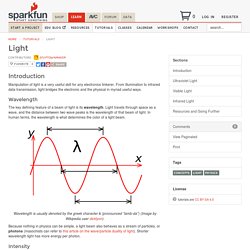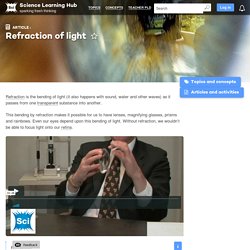

WHAT IS LIGHT. Starlight inside a light bulb. After sunset, we can see thousands of stars as white dots across the night sky.

They appear white because our eyes cannot usually detect the colour of such dim objects. However, if we look carefully at the brightest stars we can see that not all of them are white; they have different hues. And based on their colour alone, we can tell which stars are hotter and which ones are colder. The brightest star seen from Earth – the Sun – is yellow, but stars have a range of colours. Near the Orion constellation, in the winter sky, some of the stars are bright enough to discern their hue (figure 1): white/blue (Sirius, above the tree on the left), blue (Rigel, above the tree on the right), and red/orange (Betelgeuse and Aldebaran at the top centre and right, respectively). To understand the relationship between a star’s colour and its temperature, we need to observe an object close to us that, like the stars, shines because it’s hot: the filament of an incandescent lamp.
Black body radiation. Story of Isaac Newton. Light and Color. SAILS unit Light cc. Visible Light, Wavelength of Visible Light. Light is a form of electromagnetic radiation.

Human eye has the capability to detect or sense some part of the complete electromagnetic spectrum. The portion of the electromagnetic spectrum which is sensed by our human eye having wavelength in the range between 380nm and 750nm is called Visible light. Visible Light travels in straight line and the speed of light in vacuum is equal to c = 2.99792458 × 108 m s–1.
This is approximately taken as 3 × 108 m s–1. Bending Light - Index of Refraction, Light, Snell's Law. Topics Snell's Law Refraction Reflection Optics Prisms Lenses Light Description Explore bending of light between two media with different indices of refraction.

See how changing from air to water to glass changes the bending angle. Play with prisms of different shapes and make rainbows. Sample Learning Goals Explain how light bends at the interface between two media and what determines the angle.Apply Snell’s law to a laser beam incident on the interface between media.Describe how the speed and wavelength of light changes in different media.Describe the effect of changing wavelength on the angle of refraction.Explain how a prism creates a rainbow.
Version 1.1.20 The new HTML5 sims can run on iPads and Chromebooks, as well as PC, Mac, and Linux systems. iPad: iOS 12+ SafariiPad compatible sims Android: Not officially supported. Chromebook: Latest version of Google Chrome The HTML5 and Flash PhET sims are supported on all Chromebooks.Chromebook compatible sims. Electromagnetic Spectrum - Introduction. The electromagnetic (EM) spectrum is the range of all types of EM radiation.

Radiation is energy that travels and spreads out as it goes – the visible light that comes from a lamp in your house and the radio waves that come from a radio station are two types of electromagnetic radiation. The other types of EM radiation that make up the electromagnetic spectrum are microwaves, infrared light, ultraviolet light, X-rays and gamma-rays. You know more about the electromagnetic spectrum than you may think. The image below shows where you might encounter each portion of the EM spectrum in your day-to-day life. Wave Refraction 1. Wave Refraction 1 Added by Craig Napier on Dec 15, 2008 This activity explains that wave refraction occurs when an object enters a medium that makes it change speed.

Students look at simulations of light and sound waves travelling through media, to see that refraction changes the wave speed and wavelength, but leaves the frequency unaltered. This item teaches: the construction of ray diagrams to demonstrate the refraction of light the construction of ray diagrams to demonstrate the refraction of waves about the refraction of ocean waves the relationship between the speed of light and its frequency/ wavelength about the ability of sound waves to be refracted about the refraction of light about the refraction of waves the relationship between the speed of sound and its frequency/ wavelength Contents Objectives Pupils should be able to state that wave refraction occurs when an object enters a medium which makes it change speed.
Models Lists This item is not part of any lists. What Wavelength Goes With a Color? Colors We Can't See There are many wavelengths in the electromagnetic spectrum the human eye cannot detect.

Energy with wavelengths too short for humans to see Energy with wavelengths too short to see is "more violet than violet". Light with such short wavelengths is called "Ultraviolet" light. The term "ultra-" means higher than. How do we know this light exists? Energy with wavelengths too long for humans to see Energy whose wavelength is too long to see is "redder than red". Some properties of light. Light. Favorited Favorite 8 Introduction Manipulation of light is a very useful skill for any electronics tinkerer.

From illumination to infrared data transmission, light bridges the electronic and the physical in myriad useful ways. Wavelength The key defining feature of a beam of light is its wavelength. Wavelength is usually denoted by the greek character λ (pronounced “lamb-da”) (Image by Wikipedia user dicklyon). Because nothing in physics can be simple, a light beam also behaves as a stream of particles, or photons (masochists can refer to this article on the wave/particle duality of light). Intensity. Reflection and Refraction physics Animation. Refraction of light — Science Learning Hub. Refraction1 is the bending of light (it also happens with sound, water and other waves) as it passes from one transparent2 substance into another.

This bending by refraction makes it possible for us to have lenses, magnifying glasses, prisms and rainbows. Even our eyes depend upon this bending of light. Without refraction, we wouldn’t be able to focus light onto our retina3. Refraction By using the example of spearing a fish, Associate Professor Gordon Sanderson, an ophthalmologist from Otago University, explains the principle of refraction. Change of speed causes change of direction Light refracts whenever it travels at an angle into a substance with a different refractive index (optical density4). This change of direction is caused by a change in speed. The Fingerprint of Stars. SPEED OF LIGHT EXPLAINED.